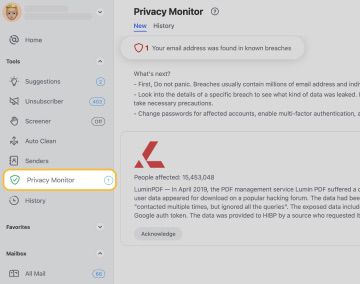Where Did My Gmail Messages Go?
There are several possible reasons that you are not getting emails on Gmail.
The emails could:
- Be in the Trash or Spam mailbox sections
- Be mislabeled and in unexpected spots
- Have been moved, deleted, or otherwise acted on by a filter
- Have been automatically forwarded to another email account
- Have been manipulated by someone with unauthorized access
For each of the above, we’ll walk through how to resolve the problem and retrieve an email that disappears. However, keep in mind that there are other possible reasons to consider if none of the above apply:
- You exceeded your storage limit and cannot receive or send emails.
- Your school or organization has retention policies that affect your messages.
- Your Gmail account was inactive or over the storage limit for 24 months or more and the messages were deleted by Google.
Now that you know why your messages may have vanished, let’s look at the best ways to find them.
1. Check the Trash and Spam in Gmail
One of the simplest solutions to missing Gmail messages is that they were sent to the Trash or marked as Spam. If this is the case, retrieving those emails is easy unless they’ve already been permanently removed from your account.
Emails in the Trash or marked as Spam are automatically and permanently deleted after 30 days.
- Open the menu on the left and select Trash or Spam.
- If you find the missing messages, select them.
- Choose Move to in the top toolbar and pick a location such as Inbox.


Switch to Clean Email’s Unsubscriber
If many of the missing emails are subscriptions and already deleted from Gmail’s Spam folder, consider managing these types of messages using the Clean Email Unsubscriber tool instead.
Along with unsubscribing from multiple mailing lists at once, you can see a list of your unsubscribed emails and even resubscribe (unblock). Clean Email lets you effectively manage subscriptions all in one spot.
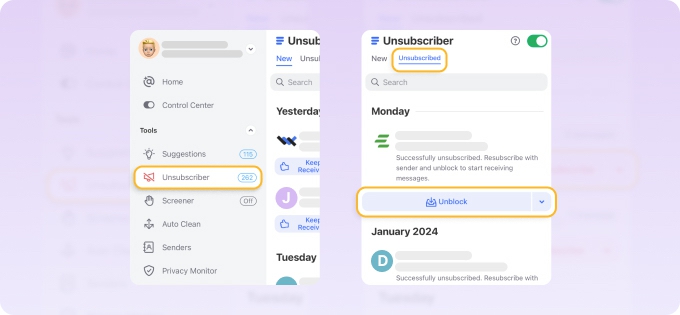
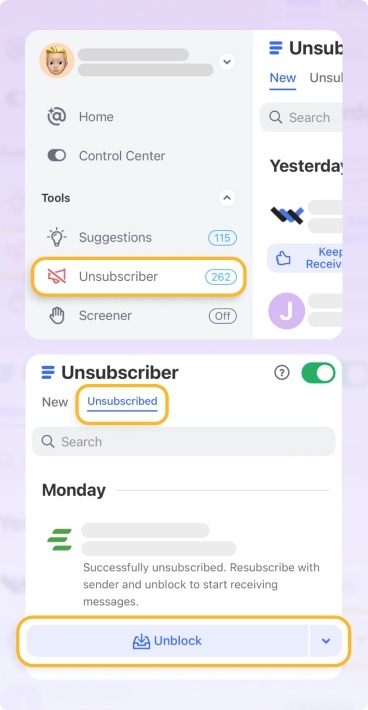
2. Search for the Emails in Gmail
If you didn’t find the missing emails in the Trash or Spam, perform a search. It’s possible that the emails were simply mislabeled or accidentally archived. (This has happened to me more than once! Using the Search, I was able to get the emails back in my inbox where they belong.)
There are many ways to use the basic and advanced search features in Gmail, both on your computer and mobile device. Here are a few simple searches you can try.
Search By Sender
For messages from particular senders, you can search using the From field.
- Select the Show Search Options icon on the right of the Search box.
- Enter the email addresses in the From field separated by commas.
- Click Search and you’ll see your results.

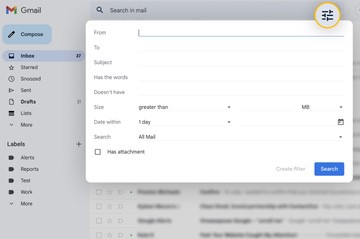
On mobile, you can enter from:[sender] in the Search box or select From below the Search bar and type in or choose a sender from suggestions.
Search By Keyword
Have you determined that your missing emails are related to a certain topic? You can search by keyword in the subject line.
- Select the Show Search Options icon on the right of the Search box.
- Enter the keyword or phrase in the Subject field.
- Click Search and you’ll see your results.
On mobile, you can enter subject:[keyword] in the Search box.
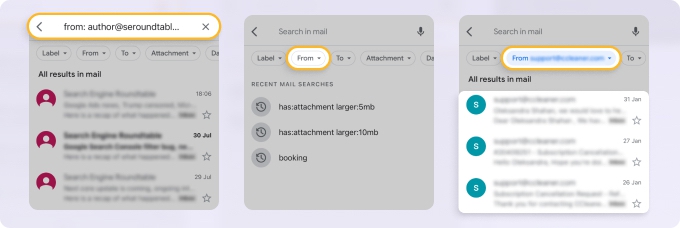
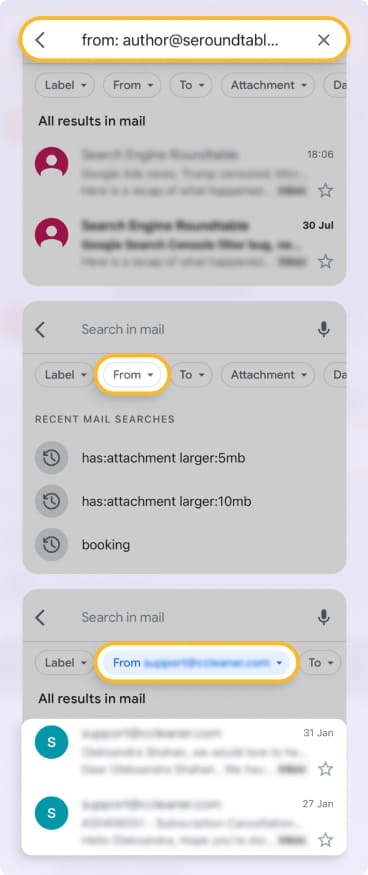
Search By Date Range
Maybe the missing messages are all from within a specific time frame. You can use the Search feature described above, but there’s a better way that works in both the web and mobile apps.
- In the Search field at the top, use the search operators for “after” and “before” for the date range.
- Press Enter or Return and you’ll then see all messages received between those two dates.
For example, to find messages between January 1, 2024 and January 31, 2024, you’d use the following: after:01/01/2010 before:12/31/2010


Use Clean Email to Group By Date
Using Clean Email, you can group your emails by date, giving you a faster way to see messages in a particular month and year.
Head to All Mail or your Inbox in the menu, select Group By, and choose Date. You’ll then see the number of messages received each month per year. Choose any group to see all emails within it.
3. Review Your Gmail Filters
While Gmail filters give you automations for acting on messages, they could also be culprits of missing emails. You may find that emails were automatically archived, labeled, forwarded, or deleted that shouldn’t have been.
- To view your filters, select the Settings icon (gear) on the top right and pick See all settings.
- Go to the Filters and Blocked Addresses tab.
- Review the filters you’ve created.
- To see a filter in detail, select Edit on the right. This lets you view the particular criteria used to act on the messages. You can also Delete the filter.
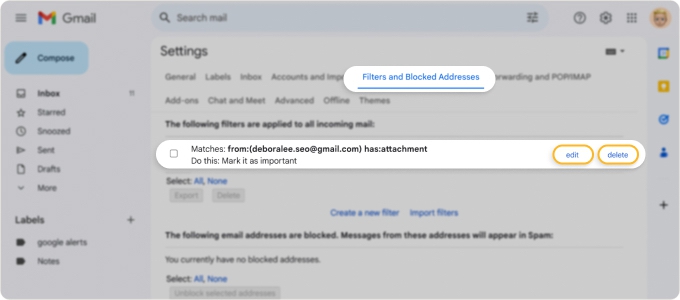
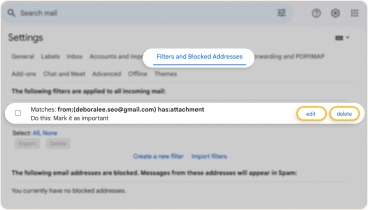
From there, you can locate the messages and (hopefully) recover them easily. Be sure to adjust your filter to prevent future emails from vanishing.
Open the Clean Email Action History
If you use Clean Email for your Gmail messages, the application’s History may help you find your emails. You can review a complete 30-day history of actions taken on your messages by you or Clean Email’s Auto Clean, Sender Settings, or Unsubscriber tools.
Select History in the menu, and pick a message or group to read, move, or take another action.

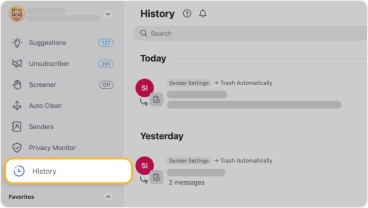
⚠️ Note: Clean Email’s History feature does not have access to filters you configure in the Gmail app.
4. Look to Your Forwarding Email Account
Maybe you’ve set up a forwarding email address or used a Gmail filter to automatically forward messages to another mailbox. You might just spot those missing messages in your other inbox or discover they’ve landed in your coworker’s mailbox.
If you didn’t set up a forwarding filter, which you can check using the steps above, you can see if there is a forwarding email for all Gmail messages. You can then make sure that copies of those messages stay in your inbox.
- Open the Settings and go to the Forwarding and POP/IMAP tab.
- See if there’s an email address next to Forwarding. If so, check that inbox for the messages.
- To eliminate the same situation in the future, select keep Gmail’s copy in the Inbox in the drop-down menu to the right of the forwarding address.
- Select Save Changes at the bottom.


📌 Tip: If archive Gmail’s copy or delete Gmail’s copy is selected in the box for Step 3, check the Gmail Archive or Trash for those messages.
5. Use the Gmail Message Recovery Tool
Tried all of the above and nothing worked to recover your Gmail messages? One more option is to use the Gmail Message Recovery Tool.
Sign in on the Gmail website and then open the Gmail Message Recovery Tool in a new browser tab. When you see your email address for confirmation, select Continue to see if Gmail can locate the missing messages.
Clean Email’s Commitment to Privacy and Security
Because Gmail’s tool is intended to help recover missing emails that may have been deleted by someone with unauthorized access to your account, you can increase your email security with Clean Email.
Not only does Clean Email have a commitment to your privacy and security but takes measures and provides tools to help you and your mailbox stay safe.
Your emails and content are not saved or stored, and your account details are encrypted and only used to perform the message actions you select. For complete details, check out Clean Email’s Privacy Policy.
Clean Email also provides you with a Privacy Monitor so that you can stay abreast of data breaches involving your email address.

